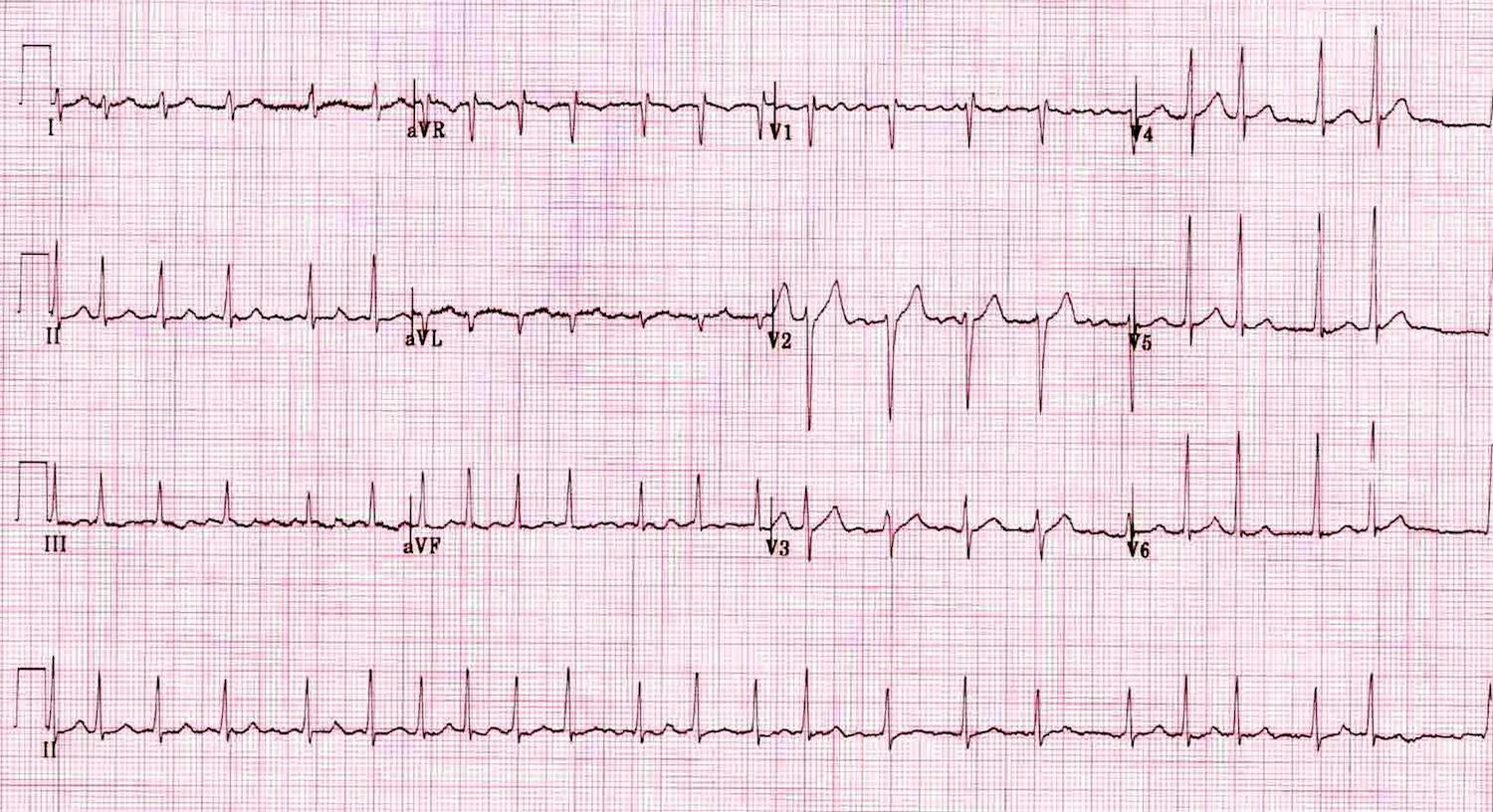ACLS Principles Flashcard 3
Rationale
D. Rationale: Idioventricular rhythm is characterized by a wide and bizarre-looking QRS complex. It has no P waves. This rhythm is one of the ECG findings in pulseless electrical activity.
Question
A patient in cardiac arrest exhibits the following ECG tracing:
What is the ECG interpretation for this pulseless electrical activity tracing?
a. Right bundle branch block
b. Third-degree AV block
c. Sinus bradycardia
d. Idioventricular rhythm
Answer
d. Idioventricular rhythm
Rationale
D. Rationale: While the defibrillator is charging, it is recommended to continue chest compressions to minimize interruptions. Once the device is charged, the patient is cleared, the paddles are placed on the chest, and the shock is given. After delivery of the shock, CPR resumes immediately, beginning with chest compressions.
Question
A patient in cardiac arrest with ventricular fibrillation needs to be shocked. While the defibrillator is charging, which of the following actions is the most appropriate to perform?
a. Clear the patient.
b. Give epinephrine.
c. Place the paddles on the chest.
d. Continue chest compressions.
Answer
d. Continue chest compressions.
Rationale
B. Rationale: Pulseless electrical activity is a cardiac arrest rhythm characterized as an organized rhythm on ECG but no pulse is felt. This can be due to adequate myocardial contractions but with a significantly diminished preload, and the heart fails to achieve a normal cardiac output.
Question
A patient is brought to the emergency department unconscious. An ECG records an organized rhythm, but you do not palpate any pulse. What is this medical condition?
a. Asystole
b. Pulseless electrical activity
c. Ventricular tachycardia
d. Ventricular fibrillation
Answer
b. Pulseless electrical activity
Rationale
A. Rationale: ECC guidelines suggest that when a defibrillator is not immediately available, a precordial thump may be considered for unstable ventricular tachycardia. “The precordial thump may be considered for termination of witnessed monitored unstable ventricular tachyarrhythmias when a defibrillator is not immediately ready for use (Class IIb, LOE B), but should not delay CPR and shock delivery“.
Question
A patient is unconscious after drowning but has spontaneous breathing and a pulse. She is connected to a defibrillator and shows the following rhythm:
While charging to give the initial dose of energy, the defibrillator short-circuited because it got wet. A new one is being requested. What can be done for the patient while waiting?
a. Precordial thump
b. Begin CPR
c. Do nothing and wait for the new defibrillator to arrive
d. Obtain intravenous access
Answer
a. Precordial thump
Rationale
B. Rationale: The team should first recognize that this patient has cardiac arrest secondary to pulseless electrical activity. Access must be established for the immediate administration of epinephrine unless it is confirmed that bag-mask ventilation is ineffective or the arrest is caused by hypoxia.
Question
A patient was found down, not breathing, and pulseless after reporting chest pain. He has the following ECG tracing:
After high-quality CPR, what is the most important next step in management?
a. Defibrillate once available
b. Provide IV or IO access
c. Insert an advanced airway
d. Synchronized cardioversion
Answer
b. Provide IV or IO access
Rationale
B. Rationale: One of the important measures to successful ACLS is the shortest time to defibrillation. When a shockable rhythm is diagnosed, defibrillation should not be delayed.
Question
A patient with cardiac arrest secondary to pulseless ventricular tachycardia is being resuscitated and on the 30th chest compression. The biphasic defibrillator was already charged and is ready to shock. What should the team do next?

a. Continue high-quality CPR for 2 minutes
b. Defibrillate
c. Insert IV line then inject epinephrine 1 mg IV bolus every 3 to 5 minutes
d. Intubate
Answer
b. Defibrillate
Rationale
C. Rationale: The prerequisites for the ACLS course are the BLS course, basic ECG interpretation, and a basic understanding of common ACLS drugs. (Course Overview)
Question
A prerequisite for taking the ACLS course is:
a. Board certification in emergency or critical care medicine
b. Medical school diploma
c. Basic ECG interpretation
d. Certification in 12-lead ECG interpretation
Answer
c. Basic ECG interpretation
Rationale
A. Rationale: There is an annual 4% increase in in-hospital cardiac arrest survival rates, according to the AHA Get with the Guidelines® program.
Question
According to the American Heart Association Get with the Guidelines® program, in-hospital cardiac arrest survival rates:
a. Increase 4% per year
b. Decrease 4% per year
c. Increase 10% per year
d. Decrease 10% per year
Answer
a. Increase 4% per year
Rationale
D. Rationale: According to the World Health Organization (WHO) in 2019, ischemic heart disease was the number one cause of death worldwide, followed by stroke. (Course Overview)
The top 10 causes of death. World Health Organization website. Accessed April 9, 2021. https://www.who.int/news-room/fact-sheets/detail/the-top-10-causes-of-death
Question
According to the World Health Organization (WHO) in 2019, the number one cause of death worldwide was:
a. Pneumonia
b. Trauma
c. AIDS
d. Ischemic heart disease
Answer
d. Ischemic heart disease
Rationale
D. Rationale: According to the World Health Organization in 2019, ischemic heart disease remains the number one cause of death worldwide, followed by stroke.
Question
According to the World Health Organization in 2019, the number one cause of death worldwide is:
a. pneumonia
b. trauma
c. stroke
d. ischemic heart disease
Answer
d. ischemic heart disease